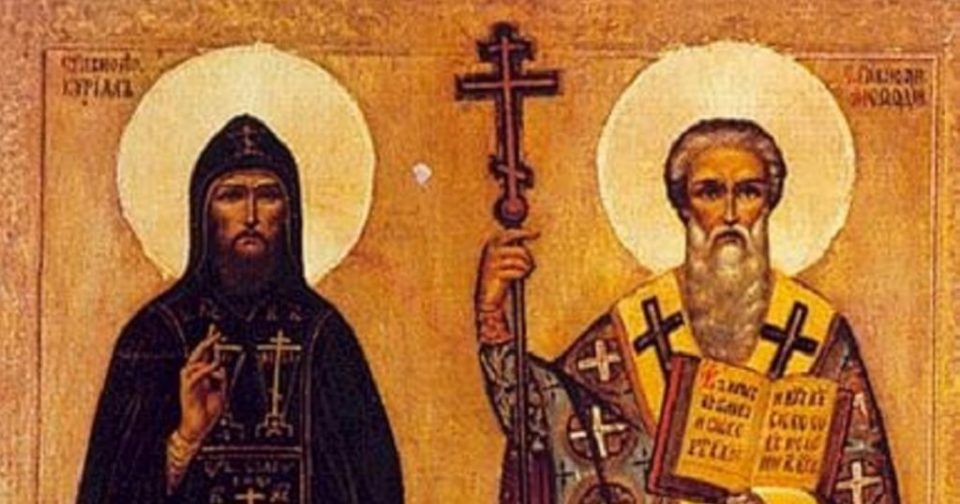Life of Saints: Saints Cyril and Methodius

Saints Cyril, Monaco and Methodius, bishop
827-869; 815-884
February 14 - Memorial (Optional memorial if the day of Lent)
Liturgical color: White (Violet if the day of Lent)
Co-Patrons of Europe and Apostles of the Slavs
Two European producers ignite the constant flame of Christianity in the East
The Cyrillic alphabet used by hundreds of millions of people in Eastern Europe, the Balkans and Russia, takes its name from today's Cyrillic. Numerous tests could be advanced for why a certain person is historically significant. Few tests, however, can eclipse an alphabet named after you. The evangelical labors of Cyril and Methodius were so overwhelming, long-lasting and culturally formed that these brothers are placed in the very first rank of the greatest missionaries of the Church. Shoulder to shoulder with brave men like Patrick, Augustine of Canterbury, Boniface, Ansgar and others, they baptized nations, gathered clans from the forests, codified laws, transcribed alphabets and collected rough pagan attempts for the divine in the transcendent worship of the one true God during the mass.
Cyril was baptized as Constantine and was known by that name until late in his life. He and Methodius came from Thessaloniki, in northern Greece, where they spoke not only Greek but also Slavic, a fundamental linguistic advantage for their subsequent missionary adventures. Cyril and Methodius received excellent education in their youth and, as they matured, received important educational, religious and political assignments at a time when those disciplines were intertwined in a strong cordon. The people, the state and the Church were an undivided whole. Cyril and Methodius served the imperial court, the only true church and their native land as professors, governors, abbots, deacons, priests and bishops.
Some time after 860 the brothers were commissioned by the emperor to Constantinople to lead a missionary crew headed for Moravia, in today's Czech Republic. They entered directly into an intricate network of political, religious, linguistic and liturgical controversies that irritated the Eastern and Central Europe to date. The Church of Rome allowed to use only three languages in its liturgical and scriptural texts - Hebrew, Greek and Latin - the three languages engraved on the head of Christ on the cross. The Church in the East, legally under Rome, but which culturally eradicated itself in its orbit over the centuries, was a mosaic of peoples in which local vernacles were used in the liturgy. Languages are always spoken long before being written, and the Slavic spoken of Moravia had unique sounds that required new letters that populated a new alphabet. Cyril created that new alphabet, and then he and Methodius translated the Scripture, various liturgical books and mass into written Slavic. This led to some serious tensions.
The newly Christianized German bishops were wary of missionaries in their own neighborhood who came from Greece, spoke Slavs and celebrated sacred mysteries in an almost Byzantine style. Moravia and the great Slavic homeland were under German ecclesiastical jurisdiction, not the Greeks. How could one say the Mass in Slavic or the Gospels translated into that new language? How could a Byzantine liturgy coexist with the Latin rite? Cyril and Methodius went to Rome to solve these various problems with the Pope and his advisers.
The brothers were treated respectfully in Rome as educated and heroic missionaries. Cyril died and was buried in the Eternal City. Methodius returned to the land of the Slavs and continued tensions with German clergymen and princes. He translated virtually the entire Bible into Slavic, brought together a Byzantine church and civil law code and firmly established, with the Pope's permission, the use of Slavic in the liturgy. After Methodius' death, however, German and Latin rite influences prevail. The Byzantine rite, the use of Slavic in the liturgy and the Cyrillic alphabet were all forced from central to eastern Europe, especially Bulgaria, shortly after his death. While they were always honored in the East, the feast of Sts. Cyril and Methodius were extended to the whole Catholic Church only in 1880. Pope St. John Paul II appointed Saints Cyril and Methodius Patrons of Europe. Their enormous legacy inspires the two lungs of the Church, both east and west, to breathe more deeply into the enriched oxygen of the entire Christian tradition.
Saints Cyril and Methodius, you have prepared yourselves for a courageous and generous service to Christ and His Church through long years of preparation and, when the time has come, you have served heroically. We can thus prepare and serve thus, until we can no longer serve.